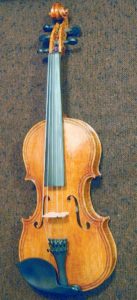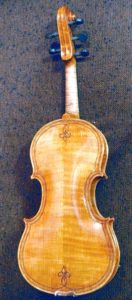Five String Fiddles and Me.
History:
I saw a five-string fiddle for the first time, many years ago, at an Old Time Fiddlers convention. (They don’t allow them in the competition, but a fellow had one there.) I wasn’t very impressed, at the time, as I recall. I was trying very hard to get a handle on building traditional instruments: classical violins and violas.
The “Nudge:”
But, years later, I was exhibiting at my first show, the Northwest Musical Instrument Show. A fellow approached my table and began asking very pointed questions. (Had I ever built a five-string fiddle? What would I charge to make one? Would I charge extra for double purfling? What differences would I anticipate in making a five-string fiddle, as compared to a normal violin? ) He turned out to be a professional fiddler, and seemed pretty intently interested in a five-string fiddle. But, he was adamant that he wanted one that would fit in his regular fiddle case. (I had suggested that perhaps a small viola with an E-string might sound better. Nope…he knew what he wanted!)
By the time he left, I was thinking,”I had better build a 5-string fiddle!”
The Build:
I had a nice violin back, salvaged from a violin of dubious origin, whose top had been stepped on, and the back was the only part worth saving. So, since the wood was pretty, and I didn’t want to throw it away, I decided to try building a five-string fiddle on that back. I established a template and a form, installed blocks and ribs, and set off on the new trail.
The front plate was some fairly dense Sitka Spruce I had stashed away, and I carved it with fairly high arching, and installed a high, thin bassbar. I had to design a new scroll that was 20 mm longer, so as to accommodate the fifth peg, without the risk of pinching fingers during tuning.
The existing purfling was not the kind I used, and not all that well done, anyway, so I removed it, and installed double purfling, as the man had indicated he wanted. I included a stylised “fleur-de-lis” in both the upper and lower back, and went ahead and completed the fiddle.
The Conclusion:
Meanwhile, I had been keeping the fiddler posted as to what I was doing: sending him pictures and progress reports. He came back to the show the following year, and really loved that fiddle (hardly anyone else got to play it!) He ultimately bought it, and he is still playing it today.
The result of that wholeexperience was that I took a serious interest in the five-string instruments, and began building them more regularly.
Here are a couple of photos of that first 5-string fiddle:


The instruments have improved over the years, as I have better learned what makes them work. But even that first attempt was a winner.
Orchestra teachers like them because they can teach both the violin and the viola parts, without having to bring an extra instrument. Players in bands like them because it adds a low-harmony capability on that C-string.
I still make them on speculation, knowing that they are popular enough that someone will eventually want them.
Five String Fiddles For Sale:
Please go to my “Chronology” page, to see what instruments are currently available. Feel free to call for prices and/or commission ideas.

